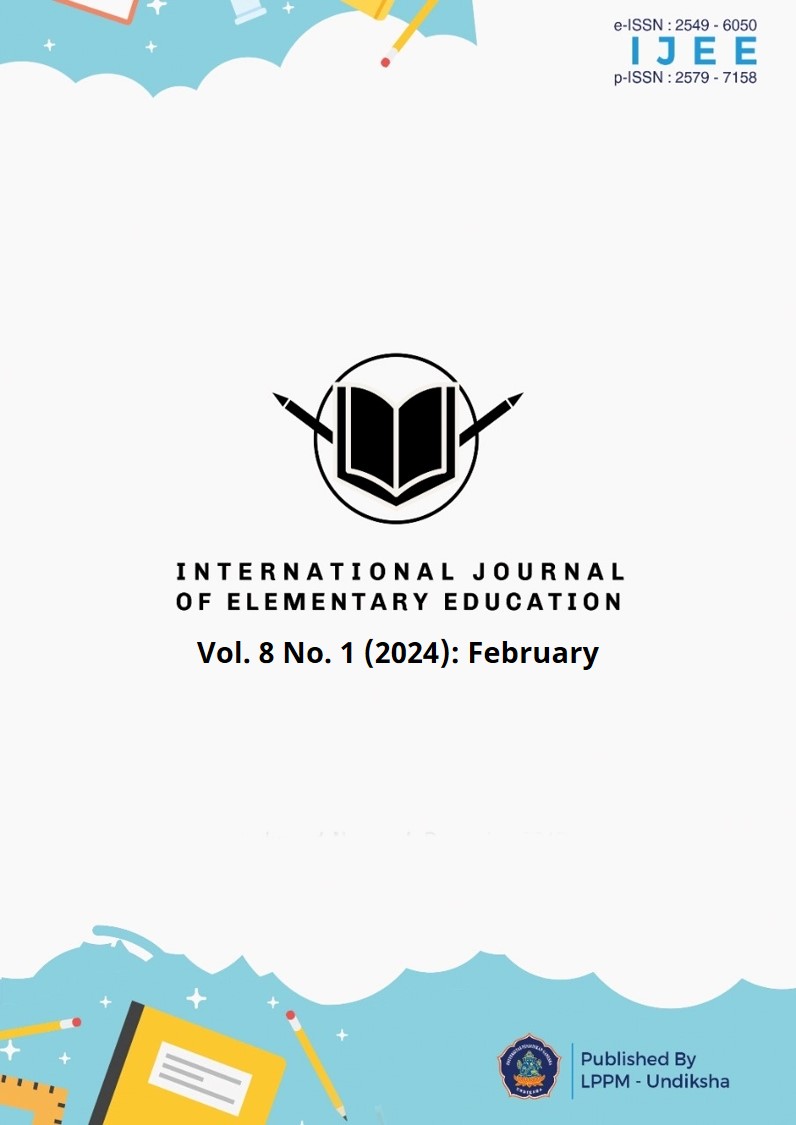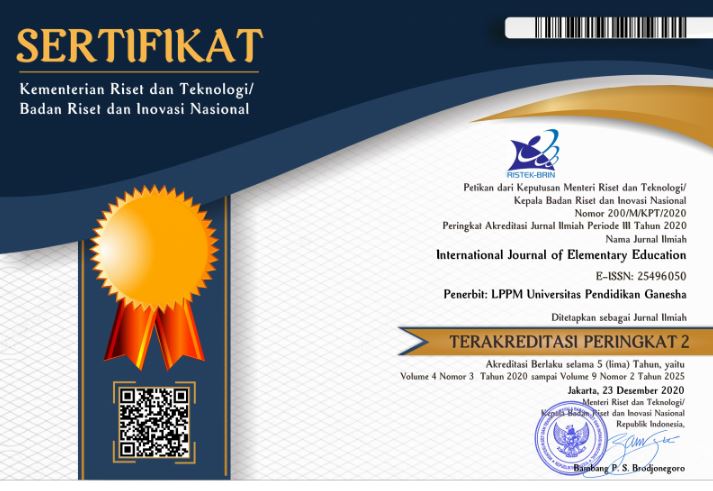The Effectiveness of Virtual Reality Media on Primary School Students' Learning Outcomes
DOI:
https://doi.org/10.23887/ijee.v8i1.67734Keywords:
Virtual Reality Media, Learning Outcomes, Thematic LearningAbstract
The development of technology today has not been fully followed by various fields of human life, one of which is the world of education. There are still problems faced such as low student learning outcomes, this factor is due to some teachers not fully utilizing technology in the learning process. This study aims to analyze the effectiveness of virtual reality media on the learning outcomes of elementary school students. The type of research used in this study is quantitative with experimental methods. The type of experimental research used in this research is a Pre-Experimental Design with One-Group Pretest-Post-test type. The data collection techniques used were observation, tests, and documentation. The data analysis technique used was descriptive analysis and prerequisite test analysis. The results of this study obtained Pretest scores with an average score of 65.07. Then obtained an average Post-test of 86.03. From the results of the T-test conducted, significant results were obtained. This is evidenced by the Sig. (2- 2-tailed) of 0.000, where the Sig. value is <0.05, so Ha is accepted and Ho is rejected Based on the results obtained, it can be concluded that virtual reality media is effective on student learning outcomes.
References
Aan, W., Saidatul, I., & Kholida, F. (2021). Implementasi Merdeka Belajar Melalui Kampus Mengajar Perintis Di Sekolah Dasar. Metodik Didaktik : Jurnal Pendidikan Ke-SD-AnJurnal Pendidikan Ke-SD-An, 16(2), 102–107. https://www.neliti.com/publications/449646/potret-kurikulum-merdeka-wujud-merdeka-belajar-di-sekolah-dasar.
Al-Gindy, A., Felix, C., Ahmed, A., Matoug, A., & Alkhidir, M. (2020). Virtual reality: Development of an integrated learning environment for education. International Journal of Information and Education Technology, 10(3), 171–175. https://doi.org/10.18178/ijiet.2020.10.3.1358.
Annisa, S., Zaenuri, Z., Kustiono, K., & Guntur, M. (2023). Penerapan Quizizz Bernuansa Etnomatematika Melalui Problem Based Learning Untuk Meningkatkan Kemampuan Berpikir Kritis Siswa. Jurnal Inovasi Pendidikan Dan Pembelajaran Sekolah Dasar, 7(1), 64. https://doi.org/10.24036/jippsd.v7i1.120960.
Aprilinda, Y., Yuli Endra, R., Nur Afandi, F., Ariani, F., Cucus, A., Setya Lusi, D., & Bandar Lampung, U. (2020). Implementasi Augmented Reality untuk Media Pembelajaran Biologi di Sekolah Menengah Pertama. Jurnal Sistem Informasi Dan Telematika, 11(2), 124–133. https://www.academia.edu/download/72745243/1701.pdf.
Ariatama, S., Adha, M. M., Rohman, Hartinio, A. T., & Ulpa, E. P. (2021). Penggunaan Teknologi Virtual Reality (VR) Sebagai Upaya Eskalasi Minat Dan Optimalisasi Dalam Proses Pembelajaran Secara Online Dimasa Pandemik. Semnas FKIP, 2. http://repository.lppm.unila.ac.id/32006/.
Boholano, H. (2017). Smart social networking: 21st Century teaching and learning skills. Research in Pedagogy, 7(2), 21–29. https://doi.org/10.17810/2015.45.
Candrasa, L., & Cen, C. C. (2023). The Effect Of Teacher Teaching, Learning Methods And Students Perceptions On The Student’s Learning Achievement In Medan City. JPPI (Jurnal Penelitian Pendidikan Indonesia), 9(1), 449–456. https://doi.org/10.29210/020221737.
Dewi, N. K. S. (2021). EFL Pre-Service Teachers’ Perception of Their Readiness in Teaching Online during Covid-19 Pandemic. The Art of Teaching English as a Foreign Language, 2(2), 163–168. https://doi.org/10.36663/tatefl.v2i1.172.
Dharma, K. Y., Sugihartini, N., & Arthana, I. K. R. (2018). Pengaruh Penggunaan Media Virtual Reality Dengan Model Pembelajaran Klasikal Terhadap Hasil Belajar Siswa Di Tk Negeri Pembina Singaraja. Jurnal Pendidikan Teknologi Dan Kejuruan, 15(2), 298–307. https://doi.org/10.23887/jptk-undiksha.v15i2.14481.
Durukan, A., Artun, H., & Temur, A. (2020). Virtual Reality in Science Education: a Descriptive Review. Journal of Science Learning, 3(3), 132–142. https://doi.org/10.17509/jsl.v3i3.21906
Faiz, A., Parhan, M., & Ananda, R. (2022). Paradigma Baru dalam Kurikulum Prototipe. Jurnal Edukatif, 4(1), 1544–1550. https://doi.org/10.31004/edukatif.v4i1.2410.
Firmadani, F. (2020). Media Pembelajaran Berbasis Teknologi Sebagai Inovasi Pembelajaran Era Revolusi Industri 4.0. KoPeN: Konferensi Pendidikan Nasional, 2(1), 93–97. https://ejurnal.mercubuanayogya.ac.id/index.php/prosiding_kopen/article/download/1084/660.
Garba, S. A., Byabazaire, Y., & Busthami, A. H. (2015). Toward the use of 21st century teaching-learning approaches: The trend of development in Malaysian schools within the context of Asia Pacific. International Journal of Emerging Technologies in Learning, 10(4), 72–79. https://doi.org/10.3991/ijet.v10i4.4717.
Halili, S. H. (2019). Technological Advancements in Education 4.0. The Online Journal of Distance Education and E-Learning, 7(1), 63–69. https://tojdel.net/journals/tojdel/volumes/tojdel-volume07-i01.pdf#page=70.
Kamińska, D., Zwoliński, G., Wiak, S., Petkovska, L., Cvetkovski, G., Barba, P. Di, Mognaschi, M. E., Haamer, R. E., & Anbarjafari, G. (2021). Virtual Reality-Based Training: Case Study in Mechatronics. Technology, Knowledge and Learning, 26(4), 1043–1059. https://doi.org/10.1007/s10758-020-09469-z.
Magdalena, I., Fatakhatus Shodikoh, A., Pebrianti, A. R., Jannah, A. W., & Susilawati, I. (2021). Pentingnya Media Pembelajaran Untuk Meningkatkan Minat Belajar Siswa Sdn Meruya Selatan 06 Pagi. EDISI : Jurnal Edukasi Dan Sains, 3(2), 312–325. https://doi.org/https://ejournal.stitpn.ac.id/index.php/edisi/article/view/1373.
Martono, K. T., Eridani, & Isabella, D. I. S. (2020). User experience pada Implementasi Virtual Reality sebagai Media Pembelajaran Anak Pengidap Autisme. Jurnal Politeknik Caltex Riau, 6(1), 1–11. https://doi.org/10.35143/jkt.v6i1.3396.
Maziyah, N., Rais, R., & Kiswoyo, K. (2022). Analisis Nilai Spiritual dalam Pembentukan Karakter pada Buku Cerita Rakyat Karya Wirodarsono. Indonesian Values and Character Education Journal, 2(1), 11. https://doi.org/10.23887/ivcej.v2i1.17924.
McGovern, E., Moreira, G., & Luna-Nevarez, C. (2020). An application of virtual reality in education: Can this technology enhance the quality of students’ learning experience? Journal of Education for Business, 95(7), 490–496. https://doi.org/10.1080/08832323.2019.1703096.
Meletiou-Mavrotheris, M., Carrilho, A. R., Charalambous, C., Mavrou, K., & Christou, C. (2020). Teacher Training for ‘Augmented Reading’: The Living Book Approach and Initial Results. Education Sciences, 10(5), 1–25. https://doi.org/10.3390/educsci10050144.
Mulders, M., Buchner, J., & Kerres, M. (2020). A Framework for the Use of Immersive Virtual Reality in Learning Environments. International Journal of Emerging Technologies in Learning, 15(24), 208–224. https://doi.org/10.3991/ijet.v15i24.16615.
Mustaghfiroh, S. (2020). Konsep “Merdeka Belajar” Perspektif Aliran Progresivisme John Dewey. Jurnal Studi Guru Dan Pembelajaran, 3(1). https://doi.org/10.30605/jsgp.3.1.2020.248.
Nayoga Yuswantoro, & Adi, A. W. (2022). the Application of Problem Based Learning (Pbl) Learning Model Assisted By Video Media To Increase Students Learning Outcomes in Thematic Learning in 4Th-Grade Elementary School. Jurnal Pendidikan Dasar Nusantara, 8(1), 90–99. https://doi.org/10.29407/jpdn.v8i1.18240.
Nessipbayeva, O. (2019). The Competencies of the Modern Teacher. Pre-Service and In-Service Teacher Training, 148–154. https://eric.ed.gov/?id=ED567059.
Pohan, S. A., & Dafit, F. (2021). Pelaksanaan Pembelajaran Kurikulum 2013 di Sekolah Dasar. Jurnal Basicedu, 5(3), 1191–1197. https://doi.org/10.31004/basicedu.v5i3.898.
Putri Ningrat, S., Tegeh, I. M., & Sumantri, M. (2018). Kontribusi Gaya Belajar Dan Motivasi Belajar Terhadap Hasil Belajar Bahasa Indonesia. Jurnal Ilmiah Sekolah Dasar, 2(3), 257. https://doi.org/10.23887/jisd.v2i3.16140.
Rahmawati, S., Paradia, P. A., & Noor, F. M. (2021). Meta Analisis Media Pembelajaran Ipa Smp/Mts Berbasis Virtual Reality. OPTIKA: Jurnal Pendidikan Fisika, 5(1), 12–25. https://doi.org/10.37478/optika.v5i1.752.
Ramli, N. R. @ B., Hashim, E., & Marikan, D. A. A. (2016). Relationship between Education Expenditure, Capital, Labor Force and Economic Growth in Malaysia. International Journal of Academic Research in Business and Social Sciences, 6(12). https://doi.org/10.6007/ijarbss/v6-i12/2510.
Rong, Q., Lian, Q., & Tang, T. (2022). Research on the Influence of AI and VR Technology for Students’ Concentration and Creativity. Frontiers in Psychology, 13. https://doi.org/10.3389/fpsyg.2022.767689.
Sari, N. A., Akbar, S., & Yuniastuti. (2018). Penerapan pembelajaran tematik terpadu di sekolah dasar. Jurnal Pendidikan: Teori, Penelitian, Dan Pengembangan, 3(12), 1572–1582. https://doi.org/10.17977/jptpp.v3i12.11796.
Saurik, H. T. T., Purwanto, D. D., & Hadikusuma, J. I. (2019). Teknologi Virtual Reality untuk Media Informasi Kampus. Jurnal Teknologi Informasi Dan Ilmu Komputer, 6(1), 71. https://doi.org/10.25126/jtiik.2019611238.
Serin, H. (2020). Virtual Reality in Education from the Perspective of Teachers. Revista Amazonia Investiga, 9(26), 291–303. https://doi.org/10.34069/ai/2020.26.02.33.
Shi, C., Wei, B., Wei, S., Wang, W., Liu, H., & Liu, J. (2021). A quantitative discriminant method of elbow point for the optimal number of clusters in clustering algorithm. Eurasip Journal on Wireless Communications and Networking, 2021(1). https://doi.org/10.1186/s13638-021-01910-w.
Silaban, P. S. M. J., Suharianto, J., Putriku, A. E., Siahaan, S. D. N., & Sembiring, J. P. B. (2022). The Effectiveness of Developing Econometrics Learning Media Based on the Website “Poetrisilaban.com” on Learning Outcomes. Proceedings of the 2nd International Conference of Strategic Issues on Economics, Business and, Education (ICoSIEBE 2021), 204(ICoSIEBE 2021), 236–242. https://doi.org/10.2991/aebmr.k.220104.035.
Sinambela, M. B. W., Soepriyanto, Y., & Adi, E. P. (2018). Taman Peninggalan Sejarah Berbasis Virtual Reality. JKTP: Jurnal Kajian Teknologi Pendidikan, 1(1), 7–12. http://download.garuda.kemdikbud.go.id/article.php?article=1683835&val=11409&title=taman peninggalan sejarah berbasis virtual reality.
Suniasih, N. W. (2021). The Effectiveness of Discovery Learning Model and Problem-Based Learning Using Animated Media to Improve Science Learning Outcomes. In 2nd International Conference on Technology and Educational Science (ICTES 2020), 38–46. https://doi.org/10.2991/assehr.k.210407.211.
Torres-Gastelú, C. A., & Kiss, G. (2016). Perceptions of students towards ICT competencies at the University. Informatics in Education, 15(2), 319–338. https://doi.org/10.15388/infedu.2016.16.
Wang, Y., Sommier, M., & Vasques, A. (2022). Sustainability education at higher education institutions: pedagogies and students’ competences. International Journal of Sustainability in Higher Education, 23(8), 174–193. https://doi.org/10.1108/IJSHE-11-2021-0465.
Wijayanti, D., & Indriyanti, P. (2017). Pendidikan Multikultural Berbasis Seni Budaya Di Sd Taman Muda Ibu Pawiyatan Yogyakarta. SOSIOHUMANIORA: Jurnal Ilmiah Ilmu Sosial Dan Humaniora, 2(1). https://doi.org/10.30738/sosio.v2i1.493.
Wijayanto, P. W., Thamrin, H., Haetami, A., Mustoip, S., & Oktiawati, U. Y. (2023). The Potential of Metaverse Technology in Education as a Transformation of Learning Media in Indonesia. Jurnal Kependidikan: Jurnal Hasil Penelitian Dan Kajian Kepustakaan Di Bidang Pendidikan, Pengajaran Dan Pembelajaran, 9(2), 396. https://doi.org/10.33394/jk.v9i2.7395.
Yantoro, Y., Hariandi, A., Mawahdah, Z., & Muspawi, M. (2021). Inovasi guru dalam pembelajaran di era pandemi COVID-19. JPPI (Jurnal Penelitian Pendidikan Indonesia), 7(1), 8–15. https://doi.org/10.29210/02021759.
Yildirim, B., Sahin Topalcengiz, E., Arikan, G., & Timur, S. (2020). Using Virtual Reality in the Classroom: Reflections of STEM Teachers on the Use of Teaching and Learning Tools. Journal of Education in Science, Environment and Health. https://doi.org/10.21891/jeseh.711779.
Yudintseva, A. (2023). Virtual reality affordances for oral Communication in English as a second language classroom: A literature review. Computers & Education: X Reality, 2, 100018. https://doi.org/10.1016/j.cexr.2023.100018.
Downloads
Published
How to Cite
Issue
Section
License
Copyright (c) 2024 Vera Yuli Erviana

This work is licensed under a Creative Commons Attribution-ShareAlike 4.0 International License.
Authors who publish with the International Journal of Elementary Education agree to the following terms:
- Authors retain copyright and grant the journal the right of first publication with the work simultaneously licensed under a Creative Commons Attribution License (CC BY-SA 4.0) that allows others to share the work with an acknowledgment of the work's authorship and initial publication in this journal.
- Authors are able to enter into separate, additional contractual arrangements for the non-exclusive distribution of the journal's published version of the work (e.g., post it to an institutional repository or publish it in a book), with an acknowledgment of its initial publication in this journal.
- Authors are permitted and encouraged to post their work online (e.g., in institutional repositories or on their website) prior to and during the submission process, as it can lead to productive exchanges, as well as earlier and greater citation of published work. (See The Effect of Open Access)









